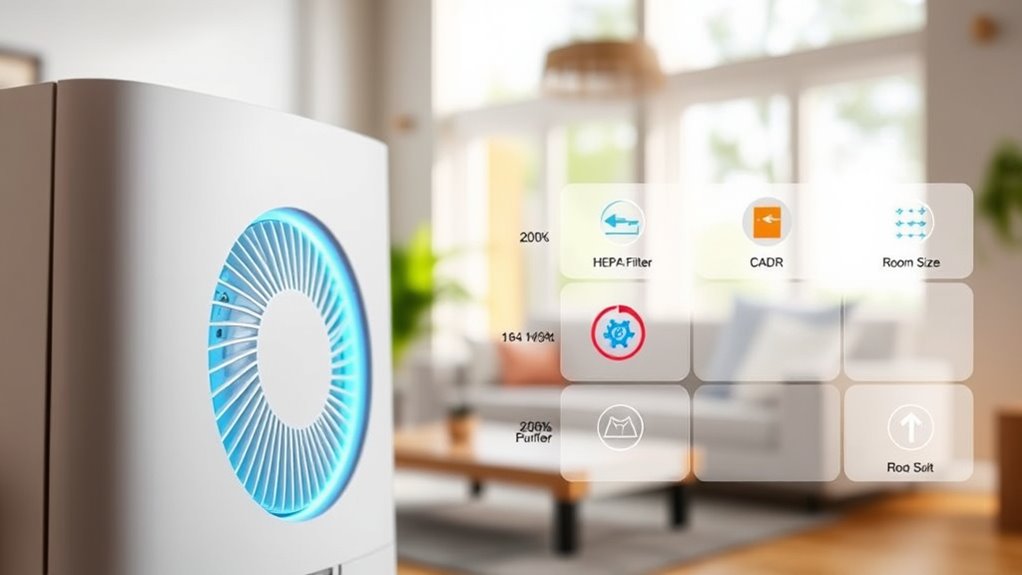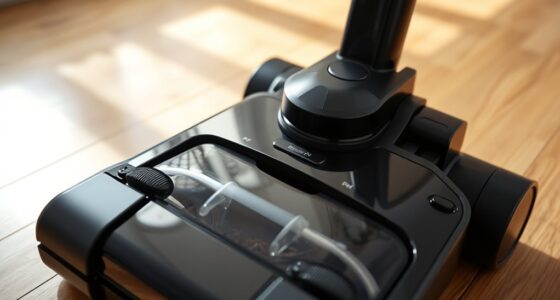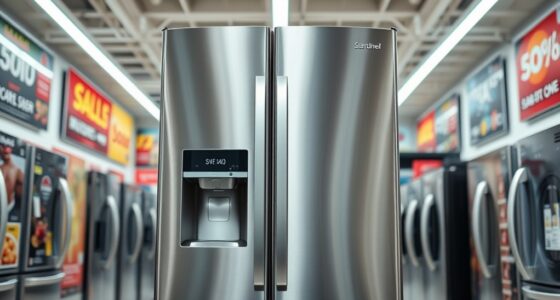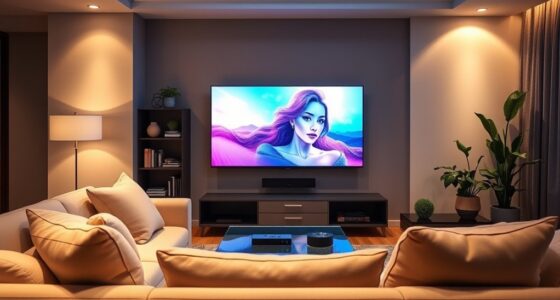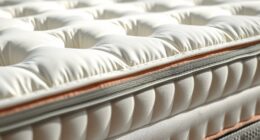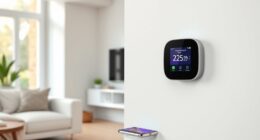To select the right air purifier, consider a model with a HEPA filter to effectively capture allergens and pollutants, especially if you have allergies or asthma. Check the CADR rating to guarantee it’s powerful enough for your room size; higher ratings mean faster air cleaning. Match the purifier’s capacity to your space for ideal results. Keep noise and maintenance in mind to choose a device that fits your lifestyle. If you want to learn more about making the best choice, stay tuned for helpful tips.
Key Takeaways
- Match the purifier’s CADR rating to your room size for effective air cleaning.
- Choose HEPA filters for high-efficiency removal of allergens and airborne particles.
- Ensure the device’s coverage area aligns with your room dimensions for optimal performance.
- Consider filter maintenance and ease of access to sustain long-term effectiveness.
- Balance noise levels and additional features to suit your environment and usage preferences.

Choosing the right air purifier can substantially improve your indoor air quality, especially if you or your family members suffer from allergies or asthma. When selecting a model, it’s essential to consider how easy it is to maintain the filter. Regular filter maintenance ensures your device continues to perform at its best, capturing airborne particles effectively. Some purifiers require frequent filter changes, while others have longer-lasting filters, so think about your willingness to keep up with maintenance schedules. Additionally, pay attention to noise levels. A quiet purifier allows you to run it continuously without disturbing your daily activities or sleep. Many modern units operate quietly on lower settings, but some can become noisy at higher speeds, which might be bothersome if you’re sensitive to sound.
Understanding the significance of filter maintenance and noise levels helps you choose a device that fits your lifestyle. A model with easily accessible filters makes routine upkeep straightforward, encouraging consistent use. Neglecting filter maintenance can lead to reduced air cleaning efficiency and potentially damage the device, so pick a purifier with clear instructions and convenient filter replacement options. As for noise, look for units with noise level specifications provided by manufacturers, usually measured in decibels (dB). If you plan to use the purifier in a bedroom or living room, opt for a quieter model, ideally operating below 50 dB on the lowest setting. If you need a purifier in a less noise-sensitive area, higher noise levels might be acceptable, especially if the device offers powerful air cleaning capabilities.
Additionally, understanding the UV radiation emitted by some models is important, as it can interact with your skin or eyes if the device includes UV sterilization features. While many air purifiers focus on mechanical filtration, some incorporate UV-C light to eliminate bacteria and viruses, which can be an added benefit for indoor air quality. While considering these factors, also think about whether the purifier’s design and features suit your needs. Some models include multiple speed settings, timers, and air quality sensors, all of which can enhance your experience. However, more features often mean increased complexity or maintenance. It’s vital to strike a balance between functionality and ease of use. Remember, the best air purifier for you isn’t necessarily the most advanced or expensive but one that you can comfortably maintain and operate without disruption. By prioritizing filter maintenance ease and keeping noise levels in check, you’ll ensure your air purifier remains effective and unobtrusive, ultimately providing cleaner, healthier air in your home.
Frequently Asked Questions
How Often Should I Replace the Air Purifier Filters?
You should replace your air purifier filters every 6 to 12 months, depending on the filter lifespan and usage. Pay attention to replacement indicators like a decrease in air quality or a noticeable drop in airflow. Regularly checking your filter helps guarantee peak performance. If you have pets or allergies, consider replacing filters more frequently. Following these guidelines keeps your purifier working efficiently and maintains clean, healthy air in your space.
Do Air Purifiers Emit Harmful Ozone?
Air purifiers can emit harmful ozone if they use ionizers or ozone generators, which produce ozone as a byproduct. Ozone emission may worsen respiratory issues and trap harmful gases. To avoid this, choose a purifier with a HEPA filter and low or no ozone emission labels. Always check the product specifications and reviews to verify your air purifier prioritizes clean air without introducing harmful gases into your environment.
Can Air Purifiers Remove Odors Effectively?
Yes, air purifiers can remove odors effectively through odor elimination filters like activated carbon. These filters trap and neutralize smells from smoke, pets, or cooking. To maintain filter longevity and keep odor removal effective, you should replace or clean filters as recommended. Regular maintenance guarantees your air purifier keeps odors at bay, providing fresher indoor air and a healthier environment.
Are There Quieter Models Suitable for Bedrooms?
Like a whisper in the wind, quiet operation models are perfect for bedrooms. You’ll find many suitable options that run silently, so you won’t be disturbed while sleeping. Look for air purifiers labeled as “quiet” or “sleep mode,” which prioritize minimal noise. These models effectively clean the air without sacrificing your peace, making them ideal for bedroom use and ensuring you breathe easy and undisturbed.
How Do Smart Features Impact Air Purifier Performance?
Smart features, like IoT integration and smart technology, enhance your air purifier’s performance by allowing you to control and monitor it remotely. These features enable automatic adjustments based on air quality, ensuring ideal purification without constant manual input. You can receive real-time updates, schedule operation, and even connect to voice assistants, making your air purifier more efficient and convenient, especially when managing indoor air quality in bedrooms or other living spaces.
Conclusion
Now that you’ve seen how HEPA, CADR, and room size play into choosing your perfect air purifier, the final decision feels just within reach. Imagine walking into your space, breathing in pure, fresh air, free from unseen pollutants. But the true secret lies in your choice—will you pick the model that promises peace of mind or the one that truly transforms your environment? The next step is yours; the fresh air awaits.
